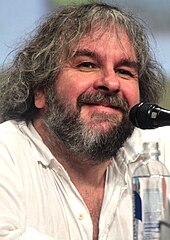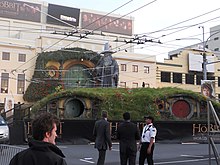The Hobbit (film series)
The films take place in the fictional world of Middle-earth, sixty years before the beginning of The Lord of the Rings and follow hobbit Bilbo Baggins (Martin Freeman), who is convinced by the wizard Gandalf the Grey (Ian McKellen) to accompany thirteen Dwarves, led by Thorin Oakenshield (Richard Armitage), on a quest to reclaim the Lonely Mountain from the dragon Smaug (Benedict Cumberbatch).
The films expand upon certain elements from the novel and other source material, such as Gandalf's investigation at Dol Guldur which leads him to the Necromancer, and the heroes' pursuit by the orcs Azog and Bolg, who seek vengeance against Thorin and his kindred.
Returning for production, among others, were illustrators John Howe and Alan Lee, art director Dan Hennah, cinematographer Andrew Lesnie, and composer Howard Shore, while props were again crafted by Wētā Workshop, with visual effects managed by Weta Digital.
In the Shire, 51-year-old Bilbo is tricked by the wizard Gandalf the Grey into hosting a dinner for Thorin and his company of Dwarves: Balin, Dwalin, Fíli, Kíli, Dori, Nori, Ori, Óin, Glóin, Bifur, Bofur, and Bombur.
The wizard Radagast the Brown finds Gandalf and the company, and recounts an encounter at Dol Guldur with the Necromancer, a sorcerer who has been corrupting Greenwood with dark magic.
Thranduil seals off his kingdom when an Orc captive reveals that an evil army is amassing in the south, but Tauriel decides to leave and assist the Dwarves and Legolas goes after her.
Inside Erebor, Thorin suffers hallucinations of being swallowed up by gold before regaining his sanity, realising his greed and selfishness and leading his company to join the battle.
[14] In March 2005, Jackson launched a lawsuit against New Line, claiming he had lost revenue from merchandising, video, and computer games releases associated with The Fellowship of the Ring.
The suit claimed New Line had only paid the Estate an upfront fee of $62,500, despite the trilogy's gross of an estimated $6 billion worldwide from box office receipts and merchandise sales.
[27] After he signed on to direct in April 2008,[28] del Toro posted on TheOneRing.net forums that he had been enchanted by The Hobbit as a child, but found that Tolkien's other books "contain[ed] geography and genealogy too complex for my prepubescent brain".
In taking the job of director, del Toro was now "reading like a madman to catch up with a whole new land, a continent of sorts—a cosmology created by brilliant philologist turned Shaman".
[31] Del Toro and Jackson considered the sudden introduction of Bard the Bowman and Bilbo's unconsciousness during the Battle of the Five Armies to be "less cinematic moments" reminiscent of the novel's greater "fairy tale world" than The Lord of the Rings, and they would change them to make The Hobbit feel more like the trilogy.
"[57][58] Two days later, del Toro announced at TheOneRing.net that "In light of ongoing delays in the setting of a start date for filming", he would "take leave from helming", further stating that "the mounting pressures of conflicting schedules have overwhelmed the time slot originally allocated for the project.
"[66] Jackson had said that del Toro's sudden exit created problems as he felt he had a very little preparation time remaining before shooting had to begin, with unfinished scripts and without storyboards, which increased the difficulty to direct it.
The Employment Relations (Film Production Work) Amendment Bill was introduced on 28 October 2010 after an urgency motion, allowing it to pass its final readings the next day, 66 votes in favour to 50 opposed.
[84] The government's legislation has been criticised as breaching the International Labour Organization's core ILO Convention 87 on freedom of association, and giving an unfair subsidy to protect multinational business interests.
[99][100] According to Jackson, the third film would make extensive use of the appendices that Tolkien wrote to support the story of The Lord of the Rings (published in the back of its third volume, The Return of the King).
[103] Shaun Gunner, the chairman of The Tolkien Society, supported the decision: "'The Battle of the Five Armies' much better captures the focus of the film but also more accurately channels the essence of the story.
"[107] Several other actors including Richard Armitage as Thorin Oakenshield, Graham McTavish as Dwalin, Aidan Turner as Kíli, Mark Hadlow as Dori, John Callen as Óin, Stephen Hunter as Bombur and Peter Hambleton as Glóin were cast later that October.
[115] Cate Blanchett, Sylvester McCoy, Mikael Persbrandt, William Kircher, Ken Stott, and Jed Brophy were cast in December as Galadriel, Radagast the Brown, Beorn, Bifur, Balin, and Nori, respectively.
On her casting, Jackson said, "Cate is one of my favorite actors to work with and I couldn't be more thrilled to have her reprise the role she so beautifully brought to life in the earlier films.
"[120] Ian McKellen, Andy Serkis, and Christopher Lee were also cast in January to reprise their roles of Gandalf the Grey, Gollum, and Saruman the White from The Lord of the Rings film trilogy.
"[140] Several actors, including Luke Evans as Bard the Bowman, Evangeline Lilly as Tauriel, Barry Humphries as the Great Goblin, and Benedict Cumberbatch as Smaug and the Necromancer, were cast in June 2011.
Speculations of his undisclosed role were further fuelled when Ian McKellen wrote on his blog that Philippa Boyens showed him Cumberbatch's screen test, stating that it was "electrifying, vocally and facially".
[184] The production employed a specialty rig designed by 3ality Technica, using two cameras and a mirror in order to achieve an intraocular effect similar to that of human sight (the distance between the eyes).
Musicians Neil Finn and Ed Sheeran contributed to the score, as did some of the actors, including Richard Armitage and the cast of Dwarves, James Nesbitt, and Barry Humphries (in the extended edition).
[197] After Jackson's decision to use High-Frame-Rate (48 frames per second) in high-definition for An Unexpected Journey was met with a mixed reception, he decided to make adjustments by altering the visuals of the following two films in the trilogy.
[69][235][236] Complaints were levelled at its "bloated" length from adapting its source material into three lengthy films without adequate preparation,[71][72][237][238][239][68] tone,[237][239] dialogue,[240] lack of gravitas and emotional weight,[239] and the emphasis on computer-generated effects.
[264] Following the expiration in 2008 of Electronic Arts' license to The Lord of the Rings, Warner Bros. Interactive Entertainment acquired the rights to develop a video game based on The Hobbit.
This demo was designed to convince The Lord of the Rings director Peter Jackson, and Guillermo del Toro, who at the time was attached to The Hobbit movie, that Traveller's Tales was capable of making a non-Lego game based on the upcoming film.









